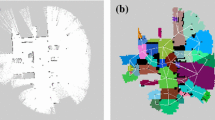Abstract
When planning a path in their environment, humans reason on a hierarchical representation of this environment. They first plan a path trough coarse zones, then refine this path during navigation, as relevant information is perceived. In this article, we propose a method that automatically generates a semantically consistent hierarchical decomposition of an urban environment. We also present a path planning process that takes advantage of this representation to delay some decisions and propose path options that enable a smart path adaptation when unexpected events occur.
Access this chapter
Tax calculation will be finalised at checkout
Purchases are for personal use only
Preview
Unable to display preview. Download preview PDF.
Similar content being viewed by others
References
Botea, A., Müller, M., Schaeffer, J.: Near optimal hierarchical path-finding. Journal of Game Development 1(1), 7–28 (2004)
Brand, S., Bidarra, R.: Parallel ripple search–scalable and efficient pathfinding for multi-core architectures. In: Allbeck, J.M., Faloutsos, P. (eds.) MIG 2011. LNCS, vol. 7060, pp. 290–303. Springer, Heidelberg (2011)
Latombe, J.: Robot motion planning. Kluwer Academic Publishers, Boston (1991)
Arikan, O., Chenney, S., Forsyth, D.A.: Efficient multi-agent path planning. In: Computer Animation and Simulation 2001, pp. 151–162 (2001)
Bayazit, O.B., Lien, J.M., Amato, N.M.: Roadmap-based flocking for complex environments. In: Computer Graphics and Applications, pp. 104–113 (2002)
Geraerts, R., Overmars, M.H.: Creating high-quality roadmaps for motion planning in virtual environments. In: IROS, pp. 4355–4361 (2006)
Geraerts, R., Overmars, M.: The corridor map method: Real-time high-quality path planning. In: ICRA, pp. 1023–1028 (2007)
Shao, W., Terzopoulos, D.: Environmental modeling for autonomous virtual pedestrians. In: Digital Human Modeling for Design and Engineering Symposium, pp. 735–742 (2005)
Pettre, J., Laumond, J.P., Thalmann, D.: A navigation graph for real-time crowd animation on multilayered and uneven terrain. In: V-Crowds, pp. 81–89 (2006)
Kallmann, M., Bieri, H., Thalmann, D.: Fully dynamic constrained delaunay triangulations. In: Geometric Modelling for Scientific Visualization, pp. 241–257 (2003)
Mekni, M.: Hierarchical path planning for situated agents in informed virtual geographic environments. In: SIMUTools, pp. 66–91 (2010)
Lamarche, F., Donikian, S.: Crowd of virtual humans: A new approach for real time navigation in complex and structured environments. CGF 23(3), 509–518 (2004)
Kallmann, M.: Navigation queries from triangular meshes. In: Boulic, R., Chrysanthou, Y., Komura, T. (eds.) MIG 2010. LNCS, vol. 6459, pp. 230–241. Springer, Heidelberg (2010)
Demyen, D., Buro, M.: Efficient triangulation-based pathfinding. In: AAAI, pp. 942–947 (2006)
Thomas, G., Donikian, S.: Modeling virtual cities dedicated to behavioral animation. CGF 19, 71–80 (2000)
Farenc, N., Boulic, R., Thalmann, D.: An informed environement dedicated to the simulation of virtual humans in urban context. Computer Graphics Forum (Proc. of Eurographics) 18, 309–318 (1999)
Jaklin, N., Cook, A., Geraerts, R.: Real-time path planning in heterogeneous environments. CAVW 24(3-4), 285–295 (2013)
Paris, S., Mekni, M., Moulin, B.: Informed virtual geographic environements: An accurate topological approach. In: Int. Conf. on Advanced Geographic Information Systems & Web Services, pp. 1–6 (2009)
Jiang, H., Xu, W., Mao, T., Li, C., Xia, S., Wang, Z.: A semantic environment model for crowd simulation in multilayered complex environment. In: VRST, pp. 191–198 (2009)
Jorgensen, C.-J., Lamarche, F.: From geometry to spatial reasoning: Automatic structuring of 3d virtual environments. In: Allbeck, J.M., Faloutsos, P. (eds.) MIG 2011. LNCS, vol. 7060, pp. 353–364. Springer, Heidelberg (2011)
Hart, P.E., Nilsson, N.J., Raphael, B.: A formal basis for the heuristic determination of minimum cost paths. IEEE Transactions on Systems Science and Cybernetics 4(2), 100–107 (1968)
Author information
Authors and Affiliations
Editor information
Editors and Affiliations
Rights and permissions
Copyright information
© 2014 Springer International Publishing Switzerland
About this paper
Cite this paper
Jorgensen, CJ., Lamarche, F. (2014). Semantically Consistent Hierarchical Decomposition of Virtual Urban Environments. In: Christie, M., Li, TY. (eds) Smart Graphics. SG 2014. Lecture Notes in Computer Science, vol 8698. Springer, Cham. https://doi.org/10.1007/978-3-319-11650-1_12
Download citation
DOI: https://doi.org/10.1007/978-3-319-11650-1_12
Publisher Name: Springer, Cham
Print ISBN: 978-3-319-11649-5
Online ISBN: 978-3-319-11650-1
eBook Packages: Computer ScienceComputer Science (R0)




